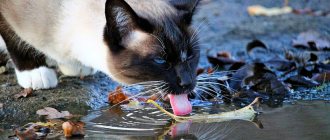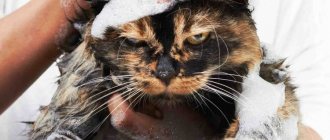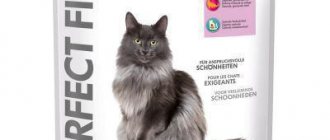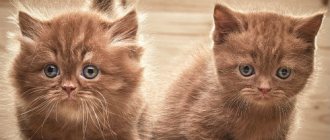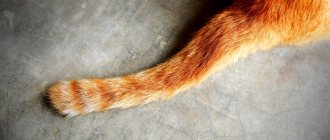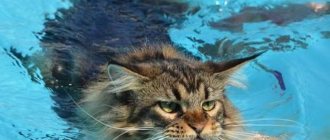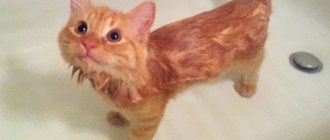Water is an essential element without which no living creature can exist. Cats are no exception; they must receive a sufficient amount of moisture for normal well-being, stable functioning of internal organs, and prevention of many diseases. At the same time, many owners are faced with the fact that the cat drinks little or refuses water altogether. What to do in such situations, how to force a cat to drink - this will be discussed further.
For picky pets, you can purchase a reliable automatic waterer, which will attract the animal’s attention every time with the murmur of water:
note
Quick view
Automatic drinking bowl for cats and dogs Feed-Ex CatH2O (1 piece)
1 PC
2 755 ₽
2 470 ₽
Show all offers
Quick view
Automatic drinking fountain for cats and dogs Feed-Ex Spring (1.8 l)
1.8 l
3 248 ₽
2 912 ₽
Show all offers
Quick view
Automatic waterer for cats Ferplast Vega Fontanella (2 l)
2 l
4 443 ₽
4 067 ₽
Show all offers
Quick view
Automatic drinking fountain for cats and dogs Feed-Ex Lotus, blue (1.5 l)
1.5 l
2 490 ₽
2 232 ₽
Show all offers
Quick view
Automatic drinking fountain for cats and dogs Feed-Ex Lotus, pink (1.5 l)
1.5 l
2 490 ₽
2 232 ₽
Show all offers
Quick view
Automatic drinking bowl for cats and dogs Feed-Ex Drinkwell Mini (1.2 l)
1.2 l
4 565 ₽
4 094 ₽
Show all offers
How dangerous is it for a cat to refuse water?
Felines by nature are light drinkers. Scientists explain this by saying that purrs descended from ancestors who lived in the desert, for whom living in arid areas and staying for long periods without fluid was the norm. In addition, pets receive a certain amount of moisture from food, provided that the owners have provided proper nutrition for the animal.
However, there is a fluid intake rate that it is advisable to adhere to:
- for adults - about 33 ml per 1 kg;
- for kittens up to one year – 70-80 ml per 1 kg.
Long-term refusal of fluids is fraught with dehydration and the development of urolithiasis, which causes a lot of problems for your pet. To prevent such a scenario from happening, you should think in advance about how to get your cat to drink. All methods will be good here, even the most creative and, at first glance, naive ones. Let's talk about them in more detail.
When to teach a kitten to lap
During the first weeks after birth, the kitten is still very small and not independent, so it is fed from a pipette. After two weeks you can switch to a nipple with a bottle.
In two weeks, your kitten will be one month old and strong enough to learn to lap milk from a bowl on its own. At one month of age, a kitten can stop bottle-feeding and be taught the adult way of feeding. What to feed a kitten? It is better to continue feeding with milk and give a little minced meat in the bait.
Water bowls should be everywhere
Cats are quite capricious animals, many of them are convinced that the whole world revolves around them. They decide for themselves where to sleep, where to play and where to drink water. Therefore, when answering the question of how to get a cat to drink water, many make a knight’s move and place containers of water in different places.
Soon the animal will independently determine in what place it will be convenient for him to drink water. Perhaps in this simple way you will be able to solve the age-old problem of how to teach a cat to drink water.
Drink for a sick cat
What fluids should you give if your cat is sick?
If a cat is sick or recovering from an illness or surgery, its owner should closely monitor how much fluid it drinks. If a cat has greater than usual needs for water, the veterinarian will definitely tell its owner about this. However, just in case, it wouldn’t hurt to ask him about it yourself. Despite all the professionalism of veterinarians and, probably, the utmost responsibility and love for their work, we should not forget that veterinarians are people too and can make mistakes somewhere or simply forget about something, especially if the veterinarian is experiencing an influx of patients. Therefore, ask, ask questions and they will answer you: as experience shows, owners who themselves ask the veterinarian questions are the most loved by them.
If the cat needs more water than usual, then it can be given in much the same way as medications produced in liquid form are given.
Introduce wet food into your pet's diet
The animal must receive a sufficient amount of moisture from food, for this purpose it is necessary to ensure that the pet eats properly. In order not to think about how to get your cat to drink water, you can transfer the purr to high-quality canned food from the holistic or super-premium segment.
At the same time, it is important to preserve the animal’s established preferences; if the cat is accustomed to eating fish-flavored dry food, the choice of canned food should be identical.
Why water is important for cats
Water is vital for any living creature. It performs important functions in the body:
- regulates body temperature;
- transports nutrients;
- necessary for digestion of food;
- helps remove toxins from the body;
- supports the functions of internal organs;
- ensures the functioning of enzymes;
- participates in the functioning of muscles, joints, eyes;
- maintains tissue elasticity.
Therefore, it is important to have enough of it in the diet. In animals that consume little fluid, concentrated urine is dark yellow in color with a pronounced odor. At the same time, they rarely go to the litter box. Constipation is also an indirect sign of insufficient fluid intake. This can contribute to the formation of sand and stones in the bladder. And also a lack of fluid can lead to weakening of the body, metabolic disorders and decreased immunity. It is necessary that your pet has unlimited access to water around the clock.
Drinking fountains
Automatic waterers have come into use among pet owners relatively recently, but have already gained an impeccable reputation and rave reviews.
Purrs love the sound of rushing water, perhaps it reminds them of life in the wild, or just gives them another reason to frolic with the water stream. Many models of automatic drinkers are equipped with carbon filters that remove unpleasant odors and keep the water fresh for a long time.
Manufacturers recommend changing them every 6-8 weeks depending on the level of fluid consumption and the quality of the water being poured.
Choose the right bowl
Cats are not only gourmets, but also true aesthetes; they will not eat or drink from just anything. It might be worth trying to buy new water containers or change them periodically in the hope of finding the one that purrs will approve.
It could be:
- automatic drinker;
- ceramic bowl;
- metal utensils;
- bowls on a stand.
Despite its absurdity, this method is often the solution to getting a cat to drink more.
How to recognize acute alcohol poisoning?
Any, even mild intoxication is a set of symptoms of intoxication. A person begins to experience noise in the ears, vision and hearing are distorted, speech becomes confused, and thinking becomes difficult. Alcohol may cause nausea, shortness of breath, and problems with coordination of movements. All these manifestations are dangerous, but not critical. They are not life threatening.
Acute ethanol poisoning occurs differently:
- consciousness becomes cloudy, becomes confused: there is no orientation in time, the person does not understand where he is, cannot answer questions;
- vomiting - profuse, prolonged;
- the appearance of seizures, trembling of the arms or legs, and other neurological symptoms;
- the skin noticeably pales, becomes bluish, lips may turn blue;
- breathing - irregular or rare (the intervals between breaths are not equal, longer than 7-10 seconds);
- body temperature decreases (falls below 36.2°C).
Important: loss of consciousness, sudden falling asleep, in which the victim cannot be awakened, are dangerous in combination with symptoms of both mild intoxication and acute intoxication. You can’t wait for a person to “sleep it off”; it’s dangerous with death. You need to urgently call an ambulance.
Order alcoholism coding
Experienced doctors and narcologists. In hospital or at home. 24-hour service in Moscow and the region. Professional, anonymous, safe.
With a high concentration of ethanol in the blood, an alcoholic coma can develop:
- superficial - a person loses consciousness, does not respond to speech, but pupillary reflexes are partially preserved, muscle tone changes (becomes low or high);
- deep: the patient is unconscious, the pupils do not react to light, body temperature drops sharply, muscles relax, pain sensitivity is lost.
After recovery from a coma or relief of acute symptoms, complications may develop:
- visual and auditory hallucinations, psychomotor agitation;
- increased convulsive syndrome;
- alcoholic delirium;
- complete or partial loss of vision (temporary);
- disorders of the respiratory system.
If there is a risk of complications after detoxification, the patient is left in the hospital to monitor his condition.
If there is a possibility of poisoning not only with ethanol, but also with other forms of alcohol, the victim needs emergency medical care, even if the symptoms are still mild. It can build up quickly. Methanol, ethylene glycol, and isopropyl alcohol, which are contained in technical fluids, lotions, household chemicals, etc., are especially dangerous. They can cause respiratory arrest, loss of vision, decreased blood pressure, vomiting (including blood), and coma.
Order alcoholism treatment
We work around the clock, experienced doctors, 100% anonymous.
Encourage your furry's quirks
If you are faced with the task of getting a cat to drink water when dehydrated, or if your pet is suffering from urolithiasis, you can use the most unconventional methods.
For example:
- allow your cat to drink from the tap, but only if it contains clean, filtered water;
- if the cat likes to drink from a cup or glass, replace the usual bowl with a new container, etc.
It is important not to resort to extremes in trying to get your cat to drink more water - do not allow him to quench his thirst in the toilet, deep buckets or running bath. Doing so may cause poisoning or may result in falling into a container of water.
What water to give a kitten
A kitten fed by a cat does not need water. He gets enough fluids with milk. The mother cat is the kitten's role model. She teaches him everything she knows and can do. A kitten without a mother may not drink water for the simple reason that it does not know how to do it. This happens if the kitten is taken away too early while the cat continues to feed it. Another reason is that the mother cat also drank little water.
© shutterstock
The kitten is not able to understand that it needs to drink water, the taste and smell of which are different from mother's milk. You will have to accustom the kitten to the taste and smell of water. You need to be careful when choosing water for your kitten. Water quality is of great importance.
Water that should not be given to a kitten:
- chlorinated;
- boiled;
- distilled.
Chlorinated tap water will not only repel the animal with its smell, but will also be harmful. You should not use boiled or distilled water because it is useless: it lacks the mineral elements necessary for metabolic processes in the body. If you pour boiled water into a bowl, after 3 hours it becomes dangerous due to infection. A sterile environment is an ideal place for microbes to multiply.
Bottled water is expensive. Settled and filtered tap water is the best option. Water for a kitten should be healthy, tasty, clean, and fresh. The kitten owner must ensure that all these conditions are met. Otherwise, getting used to water will take a long time and will require a lot of effort, including forced drinking.
In addition to the quality characteristics of water, it is important to choose dishes for water: shape, size, method of serving. The bowl should not have an unpleasant smell of low-quality plastic. In such a container, the water quickly stagnates and acquires the same smell and taste. To determine the kitten’s preferences, water is poured into several bowls of different sizes and shapes and placed in several places.
Observing the kitten will show which particular dish he will choose. The water temperature depends on the kitten’s taste, which the owner needs to find out. Fresh water can be: room temperature, chilled, heated.

